
 |
Matsubayashi-ryu Karate-doOverview | O'Sensei Nagamine's own Words | O'Sensei Nagamine and Zen| Matsubayashi-ryu Currently OverviewWhen Osensei (Grandmaster) Shoshin Nagamine (1907-1997) opened his first Dojo in 1947 he named it the ‘Matsubayashi-ryu Kodokan Karate And Kobujutsu Dojo’, and it was at this moment that Matsubayashi-ryu was born.
Based on the teachings of some of Karate’s legendary masters, including Arakaki, Kyan and Motobu (whom Grandmaster Nagamine cites as his three primary teachers), Matsubayashi-ryu though young in name, is ancient in origin, with its roots going back centuries through the history of Shorin-ryu and its constituent ‘styles’ of Shuri-te and Tomari-te.
This ‘old style’ Karate of Okinawa has not lost its original values and intent – the preservation of self, the development of righteous character and the formation of an indomitable spirit, nor has it transformed itself into a crowd pleasing competitive form, intent on creating athletes for the purpose of winning medals. Instead, it has retained its features of close quarter combat for personal protection, not training to win medals, but to succeed in life.
According to Grandmaster Nagamine in his book, ‘The Essence Of Okinawan Karate’, Matsubayashi-ryu – meaning the Pine Forest School/Style – was named in honour of Grandmaster Nagamine’s teachers – Kosaku Matsumora (teacher of Choki Motobu) and Sokon Matsumura (teacher of Chotoku Kyan).
Matsubayashi-ryu can also be pronounced Shorin-ryu; both are correct pronunciations, though when differentiation is needed between Grandmaster Nagamine’s teachings and that of another Shorin style, it is better to pronounce it Matsubayashi-ryu.
This short piece is, however, merely an introduction, and for a clearer understanding of the history, and teachings of Grandmaster Shoshin Nagamine, let us read his own words on the matter. From “Encounters with 'Ti' or 'Karate'” written by Grandmaster NagamineIntroduction
On 15 July 1907, I was born in Tomari-son,
Naha City, of my father, Shoho and my mother Gozei.
Though my physique was rather small, I was active and
aggressive as any other healthy boys in my preschool
days. Completing the compulsory education of primary
school in March 1923, I entered Naha City-run 5-year
Commercial School. However, when I was second-year
student of the school, I suffered from a gastroenteric
disorder and given a medication for some time. But,
because of inefficacy of the medication, I had to resort
to a diet, while practising Karate at the backyard of
neighbour friend, Mr. Chojin Kuba. It was in 1926 and I
was 17 years of age. Ankichi Arakaki
After graduation in March, 1928, I started
a full-scale practice, becoming the disciple of Mr. Taro
Shimabokuro of Shuri City, who was senior of me by one
year. It was my daily task to cover 8 km road between
Shuri and Naha on foot to master the art of Karate.
Thanks to the warm-hearted encouragement of brother
Taro, a hope was aroused in me, was enamoured with the
charm of martial art, and thus my appetite for Karate
surpassed that of eating. Under the guidance of another
Sensei, Ankichi Arakaki, I made further progress in the
skills of Karate. Chotoku Kyan
During my first assignment days at Kadena
Police Station, from December 1931 through August 1936,
I was deeply influenced by direct guidance of the most
famous Sensei, Mr. Chotoku Kyan who became my second
teacher. In April 1936, I was sent to the Tokyo
Metropolitan Police Department, as a trainee policeman,
and, during a six-month period I had a chance to receive
some advice about peculiar Kumite movements from then
celebrated master of Karate, Mr. Choki Motobu in Hongo
ward, Tokyo. After returning to Okinawa, I continued to
serve as a policeman of Okinawa Prefectural Police
force. Choki Motobu
On the recommendation of Sensei Chojun
Miyagi, founder of a different school called Goju-ryu, I
was given a title of Renshi in May 1940, from the Great
Japan Botoku (Respect for the martial arts) Association
at the Butoku Festival held in Kyoto, Japan. Realizing
the existence of common essence between Kendo and
Karate, I began practising Kendo in 1938. After
assiduous efforts made for some time, I was awarded a
Sandan in Kendo in 1941, and had an opportunity to
participate in the policemen's martial arts contest
among Kyukyu, Yamaguchi and Okinawa blocs which took
place in Nagasaki Prefecture. In December 1941, I was
dispatched, as a trainee, to Police University in Tokyo
and, while I was there, given a chance to demonstrate
the police-Karateman's mysteries of Karate before a
large audience of policemen of the Metropolitan Police
Special Guard Division. O'Sensei Nagamine and Zen
As famous Zen Buddhist Dogen once said,
"Accomplish what you cherish in your mind", I became, by
a happy chance, disciple of Zen priest, Sogen Sakiyama
of Enkakuji in October and began Zen meditation course
within the dojo. As the priest went to the U.S. for
preaching, I begged teachings from Keisho Okamoto,
another priest of Rengein of Itoman, and furthermore
from Shuzen Kise, priest of Jushoin of Chatan for Zen
practice. Matsubayashi-ryu Currently
Upon the death of Grandmaster Shoshin
Nagamine, the supreme authority of Matsubayashi-ryu
passed to his son, Soke Takayoshi Nagamine. Soke
Nagamine taught at the Kodokan Nagamine Dojo in Naha,
Okinawa and oversaw the development of Matsubayashi-ryu
through the World Matsubayashi-ryu Karate Association
(WMKA) and the regional member organisation European
Matsubayashi-ryu Karate Association (EMKA). Upon the death of Soke
Takayoshi Nagamine on April 25 2012,
the supreme authority of Matsubayashi-ryu passed to the
newly elected President Yoshitaka Taira (Hanshi 10th
Dan). At the General Conference of June 9, 2012, it was decided to adapt the Association President System instead of the Soke System. The current executive members as of
February 2021 are:
|